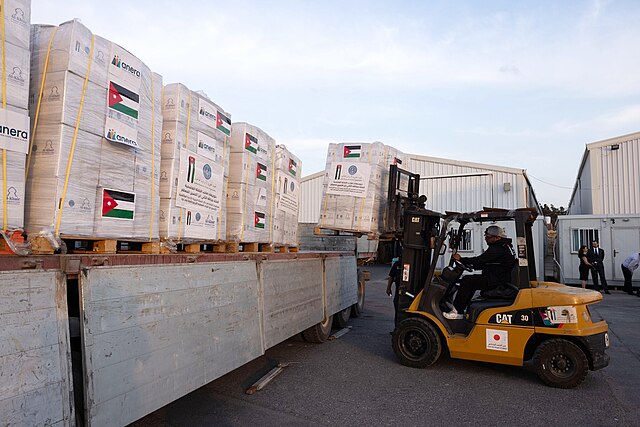|
Explosives clearance enables aid to reach victims of war in Gaza

Secretary Antony J. Blinken visits a warehouse with humanitarian aid bound for Gaza, at the Jordanian Hashemite Charity Organization in Amman, Jordan, April 30, 2024. (Official State Department photo by Chuck Kennedy)
May 01, 2024 3:58 PM
By Lisa Schlein
GENEVA —
More than 800 mine action leaders attending a U.N.-sponsored conference in Geneva this week are warning of the ongoing dangers from unexploded ordnance and landmines in countries affected by conflict.
A focus of the conference is on the war in Gaza, which the United Nations Mine Action Service, or UNMAS, says “has resulted in explosive ordnance contamination on a scale unprecedented for Gaza.”
The agency has been working in Gaza for over a decade providing services to lessen the threat of explosive ordnance to civilians and enable the safe delivery of humanitarian aid.
“After October 7, the program has undergone a rapid evolution. We have become an enabler of the humanitarian response into Gaza,” said Charles Mungo Birch, chief of the UNMAS mine action program in the Palestinian territories.
He told journalists Wednesday, “We support humanitarian convoys going north and do explosive hazard assessments of humanitarian sites which allow humanitarian work to continue.”
For example, he said that in December, UNMAS Explosive Ordnance Disposal officers accompanied a World Health Organization convoy along a dangerous route to Shifa hospital.
“That convoy evacuated over 30 premature babies, which we returned to southern Gaza, and only one of them died,” he said.
UNMAS estimates there are 37 million tons of rubble in Gaza, amounting to 300 kilos (660 pounds) per square meter of surface. This, it says, is more rubble than in Ukraine.
“To put this in perspective, the Ukrainian frontline is 600 miles long and Gaza is 25 miles long,” Birch said.
“This rubble is likely heavily contaminated with UXO [unexploded ordnance]. Clearance of this will be further complicated by other hazards in the rubble,” he said, noting that about 800,000 tons of asbestos is estimated to be in the rubble.
Paul Heslop, program manager for mine action, UNDP Ukraine, said a significant amount of contamination from UXO is found on both sides of the frontline of that conflict — however, mine clearance experts are unable to access Russian-occupied areas.
“So, we have not had any work on that side of the conflict zone,” he said. “There has been an extensive use of all types of munitions by both sides in this conflict. We are seeing a level of contamination that we have not seen in Europe since the Second World War.”
UNMAS reports 60 million people around the world are affected by the threat of land mines, leftover ammunition and explosive devices every day. It says the legacy of contamination from these weapons continues decades after a conflict ends, killing and maiming thousands of people.
The agency cites Syria, Yemen, West Africa and the Sahel region, including Ethiopia, Burkina Faso, Mali and Niger, among the most-contaminated countries in the world.
“Most of the problem in the Sahel is the IUDs, improvised unexploded devices that are homemade, similar to what we have seen in Iraq, Afghanistan, Syria, Somalia,” said Heslop, who was involved in projects in the Sahel for the past 10 years.
“Obviously, they are very low-cost and fairly easy to make. So, I think the scourge of the Sahel is the use of IUDs in a fairly indiscriminate way,” he said.
UNMAS officials said a mine clearance program the agency ran for many years in Sudan “was incredibly successful.” Therefore, they said, it is “very distressing” to see Sudan once again being contaminated by these lethal weapons, many of which now are in urban areas where the current war is raging.
Last year, UNMAS recorded 1,500 victims of explosive ordnance in the Tigray and Afar regions in northern Ethiopia, with men and young boys accounting for 80% of the victims.
Francesca Chiaudani, chief of the UNMAS mine action program in Ethiopia, said casualties are likely to remain high because the agency has received only 2% of the $10 million needed for mine clearance activities.
Another problem, she said, is difficulty in getting accreditation for nongovernmental organizations to conduct surveys and clearance activities in conflict-affected areas.
“At the moment, some limited or clearance activity has been conducted by the Ethiopian national defense forces. But there is no humanitarian clearance happening in the county because of not having authorization for organizations to do so,” she said.
However, she said, “Accreditation for international NGOs is currently in process, and we are very hopeful that at least four will be accredited in the next month.” Copyright © May 2024 Voice of America. All Rights Reserved.
Back To Country Profile
|